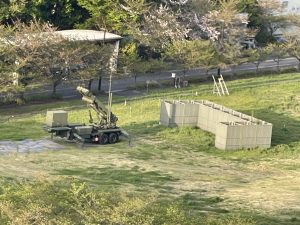Japan’s Self-Defense Forces (SDF) are deploying ground-based Patriot Advanced Capability-3 interceptor missiles and Aegis-equipped destroyer warships carrying sea-based Standard Missile-3 interceptors to prepare for North Korea’s first military reconnaissance satellite launch.
The deployment comes at a politically important time, as U.S. President Joe Biden is hosting South Korean President Yoon Suk-yeol for a bilateral summit in Washington on Wednesday. The two leaders are set to announce new steps to strengthen U.S. extended deterrence against Pyongyang.
It also comes after Japan’s Defense Minister Hamada Yasukazu on April 22 ordered the SDF to make “preparations to destroy” ballistic missiles or other falling objects that could enter Japan’s territory and harm its citizens or damage their property.
It was the first time since December 2012 that Japan issued an order for the deployment of the Patriot (PAC3) and Aegis-equipped destroyers specifically to “prepare to destroy” any missiles fired by North Korea. More generally, a standing “order to destroy” that enables the SDF to intercept projectiles was first issued in 2009, and has been continuously in effect since August 2016.
In issuing the order, Hamada was responding to North Korea’s announcement on April 19 that it was completing final arrangements to launch a military spy satellite. North Korean leader Kim Jong Un ordered technicians to speed up final preparations for launching “military reconnaissance satellite No. 1” at a “planned date,” according to North Korea’s Central News Agency (KCNA).
KCNA didn’t specify what, exactly, the “planned date” was. However, in December 2022, KCNA reported that North Korea’s National Aerospace Development Administration (NADA) said it will complete preparations for its first military reconnaissance satellite by April 2023, thus prompting Japan to be ready to shoot down any falling North Korean rocket components immediately.
To counter the growing ballistic missile threat posed by Pyongyang, Japan currently fields a multilayered, ballistic missile defense (BMD) system, with upper-tier interception being provided by Aegis-equipped destroyers such as the Kongo class, Atago class, and Maya class. Lower-tier engagement is provided by land-based PAC-3 air-defense systems.
A total of some 34 PAC-3s and its improved PAC-3 MSEs (Missile Segment Enhancements) are presently deployed in 17 fire units of the Japan Air Self-Defense Force (JASDF) across the country. The PAC-3 has an interception range of about 20 kilometers in radius. Due to the limited number of PAC-3s, the whole country cannot be covered by this air defense system only.
In such a situation, the Japanese government is now giving priority to deploying the PAC-3 system in the three islands of Yonaguni, Miyako, and Ishigaki. All three are part of the Sakishima Islands in the southern Japanese prefecture of Okinawa.
In 2012 and 2016, Pyongyang launched ballistic missiles purported to be artificial satellites, and the projectiles flew over areas near those islands.
However, Okinawans are divided on whether they should accept the deployment of the PAC-3 system, despite some imminent risks of missile or satellite debris falling on Japanese soil. More than a few Okinawans still have strong military allergies.
Okinawa Governor Denny Tamaki, a liberal Japanese politician, has urged the central government to ensure accountability to local communities and keep them informed about the situation.
Maedomari Hiromori, a professor at Okinawa International University, wrote in The Ryukyu Shimpo on April 23:
The issuance of the order to prepare for destruction measures is a dangerous move that could lead to an emergency or conflict, and is a serious diplomatic issue. Although it was not an emergency, the order was issued without formal discussion in the Diet. The Kishida administration has even decided on issues that go beyond the Constitution, such as the possession of the ability to attack enemy bases only at a Cabinet meeting.
Meanwhile, Ishigaki Mayor Nakayama Yoshitaka, a conservative politician, has shown a willingness to accept the missile units to prepare for a national security emergency, stressing that the safety of the community is the top priority.
Miyake Kunihiko, a special advisor to the Cabinet, said on a radio show aired on April 24 that deploying interceptor systems in Japan’s southwestern Nansei Island chain is a message not only to North Korea but also to China.

































